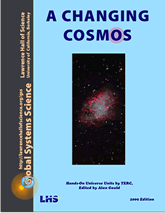AC6.2. Eclipsing Binary Stars
Many stars in the Universe are multiple star systems. If a binary star system (two stars orbiting each other) is oriented in space in a way so that the orbit plane is in line with us on Earth, then the stars alternately pass in front of and behind one another. If a star goes behind another star, it is said to be eclipsed (similar to how the Sun is eclipse by the Moon during a solar eclipse). Such a binary star system is called an eclipsing binary star.
The American Association of Variable Star Observers (AAVSO) maintains a database of observations from many observers over many years. It is a rich source of information. Their Eclipsing Binary Observing Program is described at https://www.aavso.org/aavso-eclipsing-binaries-section.
5.21. Find the longest and shortest period binary system. The most obvious thing that is different about such eclipsing binary stars other than brightness and type of star, is the time it takes for the stars to orbit one another: the period. Mine the data in the AAVSO database to see if you can find the shortest period binary system and the longest period binary system. It’s OK to coordinate your efforts with others to make things go faster.
a. Go to the AAVSO website eclipsing binaries section (https://www.aavso.org/aavso-eclipsing-binaries-section) that has links to many interesting resources as well as the EB Target list button that takes you to a table of information about eclipsing binaries.
b. Another useful resource is the Published Times of Minimum Database at http://www.aavso.org/published-times-minimum-database which has downloadable files listing the times of all the eclipses that have been observed by AAVSO observers.
c. The date/time used may seem odd to you—it’s Julian date, which is the time recorded in days and decimal fractions of days after a particular time in history: January 1, 4713 BCE. If you want to know the “normal” calendar date corresponding to any Julian date, use the AAVSO Julian Date Converter at https://apps.aavso.org/v2/tools/julian-date-converter/
5.22. Use information in the database to predict when there will be an upcoming eclipse of an eclipsing binary system and then request a series of images from a remote telescope to record the event.
Measure the brightness of the binary compared with reference stars nearby and then graph the data. If you do this for successive eclipses, you might see if one of the stars in the system is brighter or bigger than the other star by looking at the difference in drops in brightness and the shapes of the light curves that you graph. Light curves on the previous page will give you a sense of that.
Finally, you may wish to analyze a series of images of a binary star that you can find in this folder: CepheidBDCas_ARO_AndEclipsingBinary


